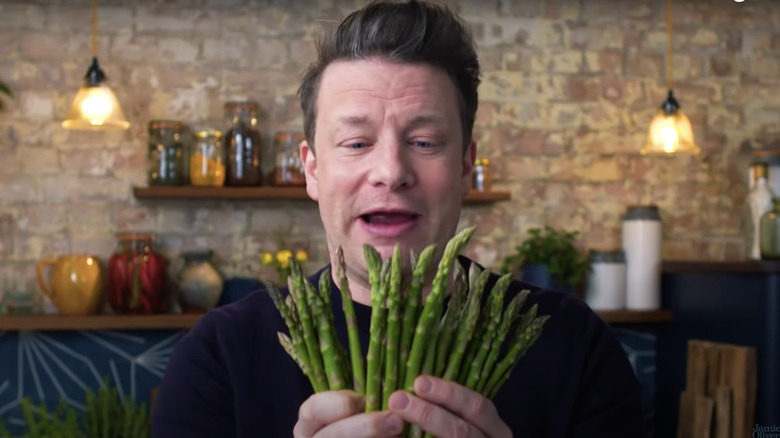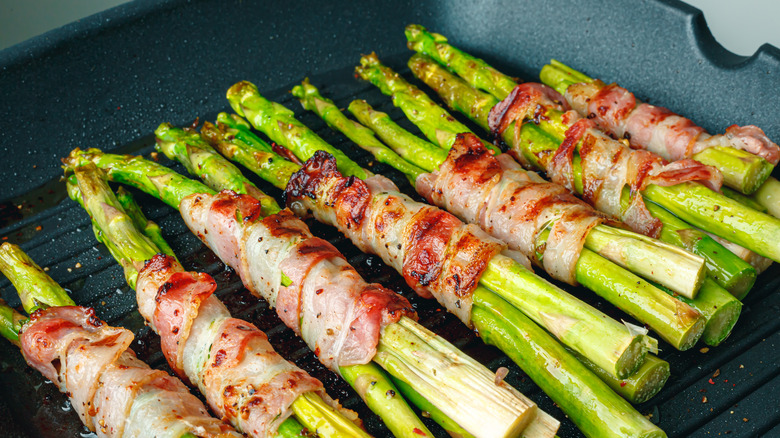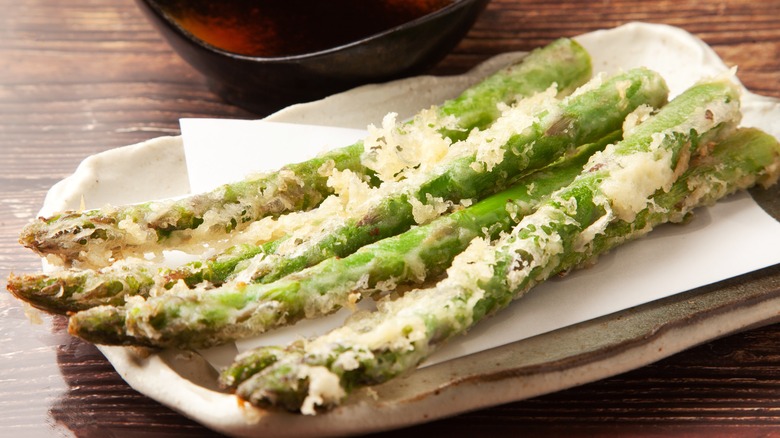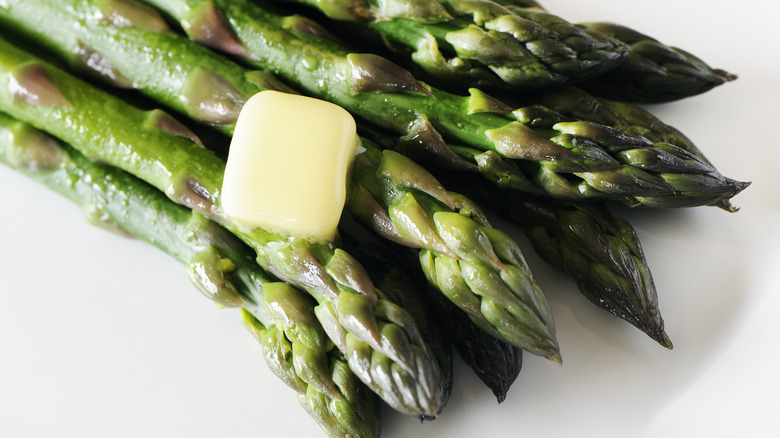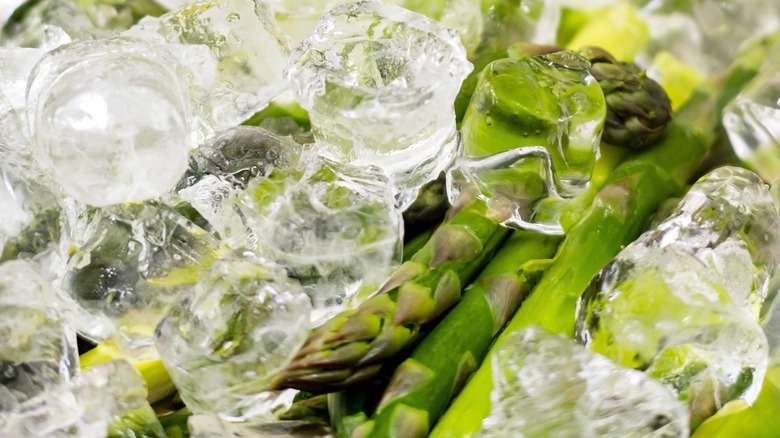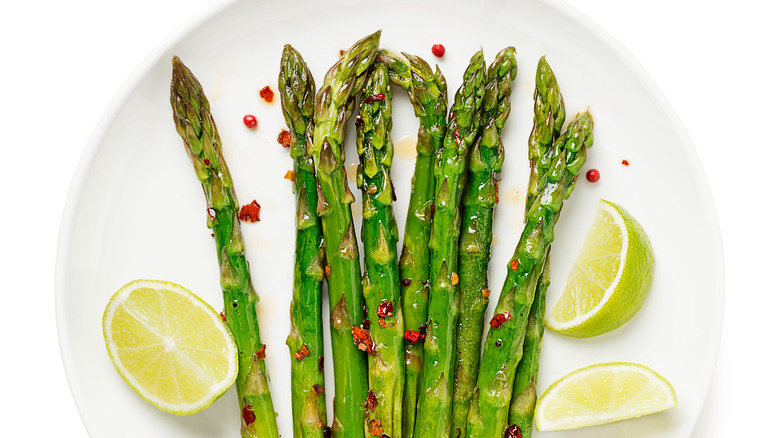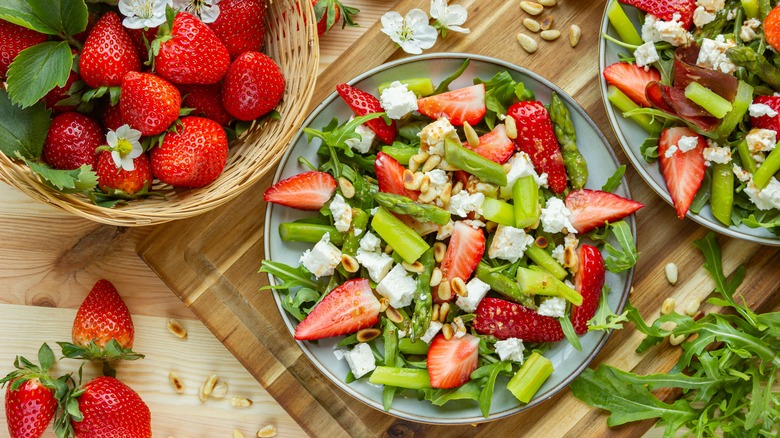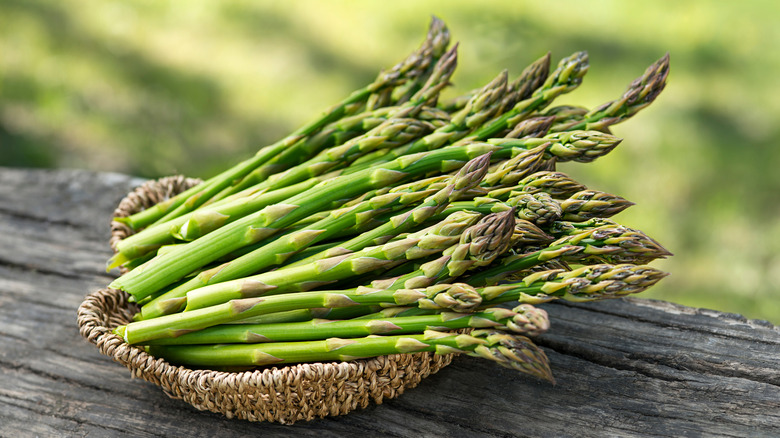13 Ways Celebrity Chefs Elevate Their Asparagus
If your asparagus comes out droopy, brownish, and stringy, you're cooking it the wrong way. If you need help with cooking this veggie, you may want to follow the advice of celebrity chefs who have proven ways of elevating asparagus to godly flavor. Everyone's got something to say about the topic — whether it's Chef Jamie Oliver, Kenji López-Alt, or Rachael Ray.
Finding new ways to prepare and season these green spears isn't novel. This vegetable has long been a culinary object of fixation. It appears in recipes in the earliest known cookbook, "De Re Coquinaria" by Apicius, a Roman gourmet. In the 19th century, the French used asparagus as an aphrodisiac, serving it at wedding feasts because of its suggestive shape. Today, asparagus continues to capture imaginations — even NPR surprised us with the news of a reported clairvoyant using asparagus (instead of tea leaves) to read the future. After sessions, she makes herself a delicious frittata. Let's dive into the methods, techniques, and ingredients used by your favorite chefs to give your asparagus the extra oomph it needs for whatever dish you're craving.
Braise it
Asparagus is prized for its fresh, crisp texture and bright green color. Common sense says to only lightly cook these green spears — lest they turn brownish and mushy. Chef Kenji López-Alt says you can go against the grain, just like when he introduced the reverse sear for steaks. Let the asparagus cook until it's tender and enjoy it. "This is not one of those bright green asparagus dishes," he said. "This is a kind of drab brown asparagus, olive green asparagus dish."
In other words, Chef López-Alt prefers braising his asparagus. This technique combines dry cooking and moist cooking. You start by browning the food you're preparing to intensify the flavor. Then, add liquid, lower the temperature, cover the pan, and reduce. Whatever you cook this way — meat or veggies — ends up tender and succulent.
To braise asparagus, you start by snapping off the woody bottoms and peeling them. Next, sauté the vegetable at high heat. Your cooking instrument should have a tight-fitting lid, but don't cover it yet. First, make sure to lightly brown the spears on both sides and some butter and half a cup of stock to the pan. After a few minutes, the asparagus becomes tender. Take the lid off and reduce the stock into a glaze. If it still seems runny, keep cooking. When the fat starts separating and floating, that means you've gone too far. Try to find the perfect middle point.
Toast it in a pan
Putting asparagus in a hot, dry fry pan may seem counterintuitive — "Won't it burn?!!!" — but that's what Chef Gordon Ramsay does. He's not a fan of boiling this veggie so he prefers to toast and then saute asparagus.
There's a good reason for this preference — depending on how you cook asparagus, different flavors come out. Lightly cooked spears have a grassy flavor but when overcooked they have a strong bitter flavor. If you don't like asparagus, you might be cooking it too long. Boiling asparagus makes it sweet while sauteing it brings out the nuttiness – that's what Chef Ramsay craves.
To follow his method, first, toast asparagus in a pan with no oil until the skin's roasted and the pan emits smoke. Then, pour in olive oil, which makes the outer membrane bubble and blister. After 45 seconds on each side, turn down the heat. Add some butter, parmesan, and lemon. Eat up the delicious result. Best of all — this method is quick and requires little labor.
Wrap it in bacon
Chefs Rachael Ray and Jamie Oliver agree that bacon is the best way to elevate asparagus — honestly, it's the way to improve most savory dishes, so no surprise there! Wrapping food in bacon makes it delicious, but adds an elegant visual aspect too. If you're trying to impress someone with your cooking, this could be your ticket. If you're only using boiled or steamed asparagus, the taste will surprise you — baking or grilling asparagus brings out a beautiful nutty flavor.
Chef Oliver meticulously wraps individual green stocks in half a piece of bacon, tucking a sprig of thyme within each one. Chef Ray is much more no-nonsense, lets-make-this-on-a-school-night about her bacon-wrapped asparagus. She advises using a slotted baking tray and seasoning the veggies with olive oil, salt, and pepper right there — it doesn't make sense to get an extra bowl dirty after all. Then wrap four or five spears with a full piece of bacon. Set these bacon bouquets on the baking pan and put them in the oven for around 12 minutes at 400 degrees Fahrenheit. This recipe is fantastic on the grill as well. Either way, you'll know it's done when the bacon is crispy.
Batter and fry it
Imagine how a spear of deep-fat-fried asparagus would feel in your mouth. Enjoy the contrast between the tender, nutty flavor of the vegetable with the crispy and salty flavor of the fried batter. Then, add the sweet-sour taste of tartar sauce to your daydream. That's paradise.
Although Jamie Oliver knows how to make delicious asparagus, he interviewed friends from around the world about how they prepare the green. One of his pals, a cook from Argentina, recommended asparagus tempura. If you're intrigued and want to attempt it as well, start by making the batter. Mix flour, cornstarch, and ice water — don't worry if it's lumpy, that's normal for this recipe. Coat the asparagus in the mixture. Next, deep-fry the batter-coated spears in hot oil. Drain them on paper towels, let them cool, and they're ready to nibble on. Finally, dip the spears in the sauce of your liking for some extra flavor — although they likely won't need it.
Put it in foaming butter
For Chef Jaques Pépin, elevating asparagus means purchasing top-quality vegetables in their prime. Asparagus' diameter doesn't indicate age, but variety. Just because the stocks are thick doesn't mean they're old. Instead, check the tips. If asparagus is past its best-used-by date, the little petals around the point start opening and become droopy. The best bunches have tightly closed petals and a firm texture.
Chef Pépin says to peel your stocks. This removes the woody part and ensures you only need to cut off the last inch. Lay the spears flat on a cutting board. Grasp your peeler with the tips of your fingers so your knuckles don't hit the cutting board. Peel down from about halfway up the stock, leaving an inch at the bottom. Peel all the way around and snap off just the very end.
Fill a small pan with water — not enough to cover the asparagus. Bring it to a boil and toss in the spears. Cover the pan so the water returns to a boil quickly. Cook it for two to three minutes. The water should reduce to a couple of tablespoons. Add a tablespoon of butter per portion and a spoonful of olive oil. Bring it back to a strong boil. The mix will emulsify into a creamy sauce around your veggies, and won't take more than a minute. Voila, you have beurre moussant, aka foaming butter. Simple, but mouthwatering.
Shave it
Chef Dan Souza says he loves asparagus so much that it drove him to a life a crime in his youth — a series of thefts from his neighbor's garden. He discovered a range of ways to prepare his pilfered greens. He says you can eat it raw — as "asparagus is a salad star" — or on the grill.
To eat it raw, pick out thicker stocks — these spears are more tender than thinner ones because they have a smaller ratio of fibrous skin to light green flesh. Lay the asparagus flat on a cutting board and use a veggie peeler to shave off thin ribbons of asparagus. Toss them with lettuce, watercress, pine nuts, and prosciutto. Alternatively, if you're feeling adventurous, throw shaved asparagus on pizza just a few minutes before it comes out of the oven.
Chef Souza has another asparagus trick up his sleeve. Salt doesn't stick to its waxy skin, so this vegetable is difficult to season evenly when grilling. The solution? Brine! Use a fork to make holes in the stems and soak the veggies in salt water for 45 minutes before charring.
Boil and then shock it in ice water
Asparagus is synonymous with a bright green color, but if you cook it too long or the wrong way it can turn brownish and floppy. Chef Kendra Nguyen has a technique to ensure she preserves the perfect color and texture for the vegetable.
Drop asparagus into boiling water with salt. Leave it there for two to three minutes. In the meantime, prepare an ice bath. Pull the asparagus out of the boiling water and submerge it into the bath. When any vegetable has been boiling, it continues to cook even after you pull it out of the hot water. Putting it in ice water stops the process. For asparagus, using this technique will preserve its color and keep it firm.
To finish off the recipe, saute some minced garlic and pepper flakes in olive oil. Stir the asparagus in the mixture just long enough to reach the perfect temperature. This garnish looks beautiful next to a steak or chicken breast.
Microwave it
People love to hate the microwave. Chef Gordon Ramsay is famous for shaming those who use it. Food writer Michael Pollan called it "antisocial." They are misguided — microwaves are wonderful kitchen tools. They are extremely efficient in preparing small amounts of food. Finish researchers calculated that this instrument saved around 75 percent of the time and 80 percent of the energy needed to prepare a meal for one person. As the number of portions goes up, the microwave's efficiency goes down.
In the face of such brutal criticism towards the little kitchen machine, Chef Geoffrey Zakarian defends the microwave when it comes to cooking asparagus. He says, "The nutrition is all in the food [when you use the microwave]...boiling asparagus, for instance, all that good stuff is left in the water." The microwave method requires putting asparagus in a dish with a couple of tablespoons of water. Cover it and microwave for two and a half minutes on high power. Season with some olive oil, salt, pepper, and lemon zest and it's ready to eat.
Slather it in vinaigrette
Asparagus is delicious all alone, so don't cover up its taste with complicated, strong-flavored ingredients. Chef Wolfgang Puck says to elevate the flavor of this vegetable with simple ingredients. He prefers a vinaigrette with a touch of mustard and mild-tasting herbs like parsley, chives, or tarragon.
First, bring water to a boil, and then immerse the asparagus in it. Leave it there for five minutes or until a knife can easily puncture the thick end of the spear. Then, immediately submerge them in cold water. Drain, dry, drizzle with vinaigrette, and serve cold.
These green spears pair well with almost any tangy sauce — like lemon, a vinaigrette, or balsamic vinegar. If you like asparagus with a vinaigrette, you may also want to try this recipe for balsamic-marinated asparagus. Make it first thing in the morning and it will be ready at dinnertime — it needs to be set for around eight hours. You can just walk in the door, home from work, open the fridge, and your meal's ready since this dish shouldn't be served warm.
Toss it in a salad
Making salad is fun. There are so many ingredients you can try in it and each one will lend a particular flavor and texture. If you've never tried adding asparagus to your salad you're missing out.
Chef Bobby Flay says to lightly saute asparagus pieces with fava beans and radicchio. Put them in a bowl with crumbled pita chips. Add a homemade dressing with Meyer lemons, dijon mustard, and honey. Top off with some shredded goat cheese. Also, it's the perfect spring-themed salad to serve with lamb.
Veggie fans could also try a spring green salad with asparagus. This one includes radish, avocado, feta, and peas. Scrumptious. Also, there's a poached asparagus salad. The co-stars here are apples and roasted hazelnuts. It just goes to show that there's no one right way to add asparagus to a salad. If these recipes aren't your cup of tea, invent your own.
Grill it
You can make asparagus using almost any method of cooking — boiling, sauteing, braising, baking, deep-frying, microwaving, and, yes, grilling. This last technique is the one Chef Giada de Laurentiis chooses, but of course with an Italian twist.
First, get your grill hot. Next, wash and trim the asparagus. Grab a jar of pesto (homemade or store-bought) and dump it over the green spears. Spread it over the stocks with your hands and then toss them on the grill for a few minutes — not too long or they'll get an unpleasant flavor. In almost no time at all, they're ready to eat!
If it seems too simple and you want to add a garnish, sprinkle on some crispy prosciutto and sliced parmesan cheese. Chef de Laurentiis prepares crispy prosciutto by baking it for 15 minutes. Then she breaks it into bits over the asparagus — not really that different from bacon. The final product looks too good to eat.
Bake it
If you're looking for something healthy to eat, asparagus is a good place to start. The Institute of Food Technologists says this vegetable is rich in fructooligosaccharides, a substance that improves immunity, contributes to bone health, and maintains a healthy balance of bacteria in the gut. Those are fantastic benefits, and if you eat roasted asparagus the way Chef Emeril Lagasse prepares it, your health may profit in other ways as well due to the ingredients he includes.
First, Chef Lagasse advises cooks to sautee pine nuts and garlic in olive oil. Then, pour it over the asparagus, already trimmed and waiting in a pan. Put the whole tray into the oven to bake until the asparagus gets tender.
What's so amazing about this dish is that the asparagus isn't even the healthiest component. Pine nuts can increase your energy, improve your skin, and keep your heart healthy. Garlic has been shown to slow the hardening of the arteries and reduce high blood pressure.
Keep it simple
Chef Billy Parisi is on a mission to make his family of four affordable gourmet meals. He picks asparagus to accompany his cordon bleu chicken. Asparagus is in season in the springtime, so buy these spears in April or May to get the best quality for the price.
The chef knows an important part of making family meals quick to make, which is one reason why his asparagus recipe is so simple. He grabs his bundle of veggies and chops off the ends. That's right, he doesn't snap them. By cutting not snapping, you end up with roughly 30% more vegetable matter left on the stalk and it's much quicker. (Stocks don't necessarily snap where the woody bottom part ends — even though that's what old wives' tales say.) Place a piece of parchment paper in the bottom of an oven pan. Then spread the asparagus atop it in a single layer. Add olive oil, salt, and pepper to the spears. Put the pan in the oven at 425 degrees Fahrenheit for up to 12 minutes and it's ready to serve. That's about as simple (and tasty) as can be!
